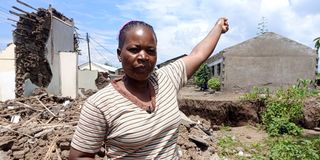Rift in the City: Signs your land is sitting on a fault line

Gilbert Obuyere, an associate professor of landscape ecology and ecosystem health during an interview at Egerton University.
Nakuru has recorded several fissures in the recent past, with areas of Kiamunyi, Kaptembwo and Kiambogo recording the recent activities of the ground opening up or sinking in.
According to locals, this starts with a tiny crack on the ground that later turns into humongous sink holes or fissures.
Some say, they never saw this coming.
For instance, Jane Angolo, from Kaptembwo notes that before her land sank, she would see water seeping into the ground whenever it rained but could not tell where it went.

Jane Angolo, from Kaptembwo estate in Nakuru city.
Shortly after, fissures crisscrossed her property, leaving her homeless.
The same was witnessed in May 2024, in Kiambogo where a 50-meter-deep fissure developed in a farm, unearthing the wrath of mother nature.
Not forgetting the 2018 split that opened up a 50 feet deep gorge stretching 20 meters wide in Mai Mahiu.
With each case recorded and more dating back to the 90s, the biggest question remains how then can you know if your land sits on a weak area or along a fault line?
Mtaa Wangu sought the opinion of an expert and residents on how they can tell if their land sits on a ticking bomb.
Our first stop sets us at a confectionery shop close to highway towers in the city center, where Keziah Wambui notes that she fears the area around Highway towers may be on unstable grounds.

Keziah Wambui a trader at Highway towers in Nakuru city.
“At times when we sit at the shop we can feel tremors as trucks move on the highway," she explains.
On the other hand, Susan Chemweno from Technology farm area, says from her home there are intense tremors when the train passes by.

Susan Chemweno from Technology farm in Kaptembwo.
Other than that, she notes that while digging pit latrines, the soil structure is made up of loose ashy soil.
Ms Chemweno reveals that this has resulted in latrines caving in.
"One morning we woke up to the roof of the toilet on the ground and the rest of the structure sunken," she reveals.
Echoing her sentiment, Landscape and Ecology professor at Egerton University, Prof. Gilbert Obwoyere says one can tell of unstable grounds from the soil profile while digging pit latrines.
"The soil profile in Nakuru is mostly volcanic ash. Mostly, within two meters of the depth of the soil, you end up with only volcanic ash soil. You don't easily get a bedrock in Nakuru. True to it, in areas of weakness, toilets are the first to disappear," he notes.
Prof. Obwoyere says, "The geology of Nakuru is prone to underground erosion especially if water finds an area of weakness. This is one of the reasons fissures may be prone in Nakuru."
As he concludes, he says that since Nakuru has borne the brunt of the splits, the government should mark areas with fissures and sinkholes as risk areas and limit people from frequenting the place.
"These are not attraction sites. There could be underground activities going on unknown to people that could be catastrophic if left unattended," he says.
